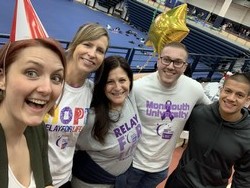Before the COVID-19 pandemic, students would shuffle into classrooms, sit down at their desk, and strike a conversation with the student next to them before class officially began. Flash forward a year later, and students are sitting in front of the computer screen logging into their classes with the click of a link.
While students could once converse with their peers before and after a class, they now find themselves alone as soon as the professor hits “end meeting.” Students are now forced to adjust to everything virtually—taking classes, completing tests and quizzes, and even making friends. For many students, this adjustment has not been easy. Many have found it difficult to create connections with their peers and professors.
Breasia Love, a junior business student, is one of many who have found difficulty in making friends during online classes. “I noticed that the professors who do not enforce the webcam or utilize breakout rooms indirectly influence the way students interact via Zoom,” she said. However, she noticed that it is easier to create bonds when her classmates reach out via email or private chat on Zoom.
“I don’t think you can really make connections unless you’re in a breakout room,” said Jessica Ciarczynski, a junior communication student. “It can be awkward at first, but once you get past the few minutes, it can be nice to have one-on-one conversations.”
Love shares a similar sentiment with Ciarczynski. “Breakout rooms become awkward when they are randomized,” she said. “However, my professors have been good with keeping the same faces in the breakout rooms.”
Mona Cobb, a junior political science student, has faced similar difficulties as Ciarcynski and Love. “It is harder to start a conversation with someone on Zoom,” Cobb said, “especially if there are no breakout groups to help break the ice for conversations…it [also] depends on if the camera is on or off for the people in the group.”
Student Activities has attempted to re-cultivate the sense of connection that has been lost due to online learning, therefore helping students make new friends and bond in the digital world. For example, they host trivia and game nights each week to break the monotony of the semester.
Love has not attended any virtual events this semester due to schedule conflicts. She said, “Most of the events take place later in the night. I am usually at work around this time, doing homework or practicing self-care.”
However, she has not completely dismissed the idea of attending a virtual event. “If an event excites me, I may log on, but I have not done so since moving to virtual events,” she said.
Ciarczynki, Love, and Cobb shared advice for other students in order to be more active and attentive in Zoom classes.
Love said, “I would recommend keeping your camera on, as you are more likely to pay attention, as well as setting your phone aside. Also, finding a comfortable place to sit will boost your attentiveness.”
Being attentive in class will boost your participation, which can help foster a sense of connection in virtual classes. Just by participating and paying attention to your classmates, you can learn something about them and discover if you have a common interest.
“Getting the phone numbers of classmates when you are in the breakout groups can be helpful because you ask for help outside of class,” Ciarczynski added. “Organizing study groups that meet outside class hours will not only help you make friends, but also help you excel in your classes.”
One last piece of advice: Make the best out of the situation at hand, and only then will we learn to survive in the digital world.
IMAGE TAKEN from Pexels.com




